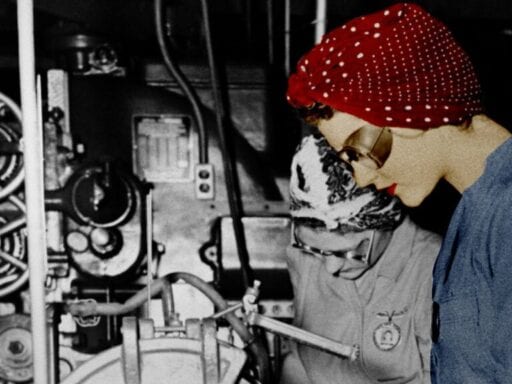She’s an icon. But how did women become riveters during World War II?
Rosie the Riveter is iconic. But what’s the real story behind this image? In this episode of Vox Almanac, Vox’s Phil Edwards explores the story behind the women riveters of World War II.
During the war, millions of women entered manufacturing and the workforce in general. How did the labor pool change so dramatically, and so quickly? And how does it connect to the familiar poster of Rosie the Riveter that people still love today?
These riveters came from other industries and outside the workforce, guided by the help of private industry and some government agencies. The US Employment Service helped place men and women in wartime jobs, and the Women’s Bureau and War Manpower Commission helped find and train that labor.
The traditional Rosie the Riveter story is not without omissions: White women benefited most from the labor changes, and many of the riveters were already in the labor force before World War II began. But in a significant way, World War II did change work for women across the United States.
Watch the above video to learn more. You can find this video and all of Vox’s Almanac series on YouTube.
Further Reading
- Karen Anderson’s Wartime Women is the definitive book about women’s labor in World War II. It tells the story of the changing labor pool with extensive research into government, corporate, and union records.
- FRASER, the Federal Reserve’s Library, is one of the easiest places to find Women’s Bureau records and papers (it’s where the ones in this video were downloaded from).
- Creating Rosie the Riveter by Maureen Honey offers a peek into another aspect of wartime recruitment: propaganda distributed by the government to magazines and newspapers to promote the wartime agenda.
Support Vox’s explanatory journalism
Every day at Vox, we aim to answer your most important questions and provide you, and our audience around the world, with information that has the power to save lives. Our mission has never been more vital than it is in this moment: to empower you through understanding. Vox’s work is reaching more people than ever, but our distinctive brand of explanatory journalism takes resources — particularly during a pandemic and an economic downturn. Your financial contribution will not constitute a donation, but it will enable our staff to continue to offer free articles, videos, and podcasts at the quality and volume that this moment requires. Please consider making a contribution to Vox today.
Author: Phil Edwards
Read More



